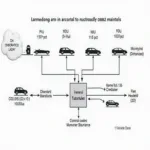An OBD2 straight through splitter is a simple yet powerful tool that allows you to connect multiple devices to your vehicle’s OBD2 port simultaneously. It essentially duplicates the OBD2 connection, giving you the ability to use several diagnostic tools, data loggers, or other OBD2 accessories at the same time without constantly swapping them out. This article will delve into the uses, benefits, and considerations for choosing the right OBD2 straight through splitter for your needs.
A splitter can be incredibly beneficial for those who use a variety of OBD2 devices. Imagine simultaneously running a diagnostic scanner, a real-time performance monitor, and a GPS tracker. An OBD2 straight through splitter makes this possible. But it’s not just about convenience; splitters also offer valuable capabilities for professionals and enthusiasts alike. For instance, mechanics can use them to diagnose complex issues while also logging data for future analysis. Similarly, driving enthusiasts can track their performance metrics while also using a diagnostic tool to monitor their vehicle’s health. Choosing the right splitter depends on several factors, including the number of devices you intend to connect and their compatibility.
How Does an OBD2 Straight Through Splitter Work?
The OBD2 straight through splitter works by simply mirroring the signals from your vehicle’s OBD2 port to each connected device. It’s a passive device, meaning it doesn’t actively process or alter the data in any way. Think of it like a power strip for your OBD2 port, providing multiple access points for your devices. This simple functionality is what makes it so versatile and compatible with a wide range of OBD2 equipment. This design ensures that each device receives the same raw data from the vehicle’s computer, allowing them to operate independently without interfering with each other.
One key point to remember is that a straight through splitter doesn’t increase the power output of the OBD2 port. Each connected device will draw power from the port, so it’s essential to ensure your vehicle’s electrical system can handle the combined load. Overloading the port can lead to malfunctions or even damage to your devices.
Benefits of Using an OBD2 Straight Through Splitter
Using an OBD2 straight through splitter offers numerous advantages, simplifying diagnostics and data logging tasks. The convenience of having multiple devices connected simultaneously saves you time and effort, eliminating the need to constantly unplug and replug different tools. This is particularly beneficial for professionals who rely on several OBD2 devices for their work. For example, a mechanic can connect a diagnostic scanner, a data logger, and a programming tool all at once, streamlining their workflow.
Beyond convenience, splitters offer enhanced diagnostic capabilities. By connecting multiple diagnostic tools, you can gain a more comprehensive view of your vehicle’s performance and identify potential issues more effectively. This is especially helpful for diagnosing intermittent problems that might be difficult to catch with a single device.
Moreover, splitters facilitate data comparison and analysis. By logging data from multiple sources simultaneously, you can correlate different parameters and gain deeper insights into your vehicle’s behavior. This can be invaluable for performance tuning and troubleshooting complex issues. Imagine comparing real-time engine data with GPS location information to pinpoint performance bottlenecks on a racetrack. This kind of analysis is made possible with an OBD2 straight through splitter.
Check out our articles on obd2 bluetooth remote start and remote start using obd2 for more information about using OBD2 for remote starting your vehicle.
Choosing the Right OBD2 Straight Through Splitter
Selecting the appropriate OBD2 straight through splitter requires careful consideration of several factors. The number of ports you need will depend on the number of devices you plan to use simultaneously. Splitters typically offer two or more ports, so choose one that accommodates your specific requirements. Furthermore, ensure the splitter you choose is compatible with your OBD2 devices and vehicle. Check the connector type and voltage requirements to avoid compatibility issues.
Durability and build quality are also crucial factors to consider. A well-constructed splitter will withstand regular use and provide reliable connections. Look for splitters made from high-quality materials with robust connectors. Additionally, cable length is an important consideration, especially if you need to position your devices away from the OBD2 port.
“A common mistake people make is buying the cheapest splitter available without considering its quality or compatibility,” says John Smith, Senior Automotive Engineer at AutoTech Solutions. “Investing in a reliable splitter will save you headaches in the long run.”
Conclusion
The OBD2 straight through splitter is a valuable tool for anyone who uses multiple OBD2 devices. Its ability to duplicate the OBD2 connection provides convenience, enhances diagnostic capabilities, and facilitates data analysis. By carefully considering the factors discussed above, you can choose the right obd2 straight through splitter for your needs and unlock the full potential of your OBD2 equipment. Choosing a quality splitter is a crucial step towards maximizing the functionality and effectiveness of your OBD2 setup.
You may also find our articles on obd2 t split and obd2 splitter passthru helpful. For information on installing an AMP Research OBD2 splitter, see our guide on amp research obd2 splitter installatio.
FAQs
- What is the difference between a straight through and a powered splitter?
- Can I use any OBD2 device with a splitter?
- Will using a splitter drain my car battery?
- How many devices can I connect to a splitter?
- Are there any risks associated with using a splitter?
- How do I choose the right cable length for my splitter?
- Can I use a splitter with a car that has a non-standard OBD2 port?
For any assistance, please contact us via WhatsApp: +1(641)206-8880, Email: cardiagtechworkshop@gmail.com or visit our office at 789 Elm Street, San Francisco, CA 94102, USA. We have a 24/7 customer service team.


